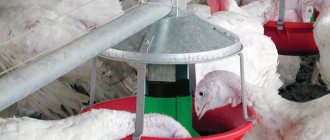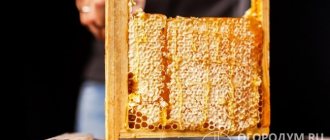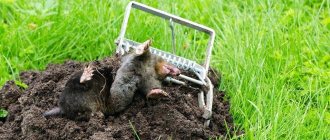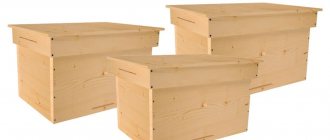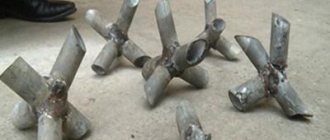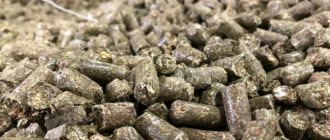Milking small cattle is an energy-intensive process, quite inconvenient and nervous for both parties. Animals, especially young ones, kick in a cramped stall and often spill a container of milk. A goat milking machine is the simplest and optimal solution for convenient milking. This device immobilizes the animal during this process, which greatly facilitates the farmer’s work. You can buy the machine ready-made or make it yourself. Today, farmers and even large livestock farms choose this option, since with this device goats can be milked either manually or using a special milking machine.
Installation steps
The 2 legs should be connected to a strong, reliable base of the structure - an end that should pass through their tops (as shown in Figure 1).
Repeat the steps with the remaining 2 legs on the second side of the machine. Next, you will need to connect the resulting parts to the sidewall, focusing on the upper end (Figures 2 and 3). The next step is to install and secure the beams (2 pcs.). The distance from the edges should be 40 cm. Adjust the angles of the base as necessary (they should be 90°). The next step is to secure the boards intended for flooring (Fig. 4). A mandatory action is to round off all sharp corners and edges (necessary to reduce the risk of injury).
The machine elements intended for assembling the stand and holding mechanism are shown in the diagrams:
- E – racks (2.5X10X50, 2 pcs. in total);
- G – parts (2.5X 10X50 cm, 4 pcs. in total);
- F- fixing slats (2.5x10x120 cm, 2 pcs. in total).
The process of assembling the stand, as well as the holding mechanism, is carried out in several steps.
The corners of the stand are cut off - you need to draw a line from one corner at the top down 10 cm and to the left 5 cm and saw off (the dotted line in Figure 5). Attach 2 parts to racks 1 and 2 - one of them is level with the upper ends, the second - at a distance of 10 cm from the lower ends. Then fasten the remaining 2 elements on the other side so that they are opposite the parts (Figure 6). Create a hole at the fixing slats at a distance of half a meter from the bottom so that the animal’s head can pass through. Additionally, this rail (1 in Figure 6) will need to cut a corner (top 10 cm, left 5 cm). Next, install the fixing rail 2 in the center of the resulting structure in point 2 between the two parts and secure it - for immobility. Fixing rail 1 is installed at a certain distance from fixing rail 2 - this creates a moving part that secures the position of the head. The lower part of the element will need to be attached with a bolt by drilling a hole (Figure 7).
The mount for installing the feeder depends on the chosen design. At the end of the work you need:
- connect the base to the stand - the lower part should rest on the boards intended for flooring, fastening is done through the stands (1 and 2), as well as the fixing rail 2;
- attach the corner brackets (Figure 8).
The locking device is chosen as desired - a hook or a fastening cord.
Basic requirements for equipment
The main element of the pen is the cage or stall. It is made to the size of a goat or slightly larger. Adjacent to the stall is a head restrainer equipped with a feeder into which the animal’s favorite food, such as barley, is poured. The clamp should securely hold the neck, preventing the cattle from quickly removing its head. The bottom of the stall - the flooring or stand - must be strong enough and have a ladder or ladder for lifting.
Expert opinion
Zarechny Maxim Valerievich
Agronomist with 12 years of experience. Our best country expert.
Ask a Question
The locking mechanism of the holding device is considered separately. It is required to ensure that the doors are tightly closed or the slats are connected without backlash.
Arrangement of the barn
The interior decoration of the premises takes into account the peculiarities of keeping goats. In addition to finishing work, it is necessary to provide special devices to facilitate the care of animals.
Stall
Stalls can be shared or individual. Goats should not be housed in such a way that they are cramped. This will affect the overall psychological state of the animal. For an adult goat, you need to calculate 1-1.5 square meters of free space. Between the stalls it is necessary to erect walls 1.5-1.7 meters high. The front part of the stall, separated by a door, should have a hollow part at the level of the goat's muzzle. This is a kind of house for a pet.
Shared stalls require separate housing for goats and bucks. If goats are kept next to goats, then after milking the milk develops a peculiar smell. In the area of the common stall, it is necessary to build individual beds for goats. They should be raised above the floor and covered with hay. Goats rest on the beds and sleep at night.
Feeder
For feed you need to equip 3 devices:
- Nursery. This is a device that is designed to accommodate hay. The mangers are boxes made of lattice materials from which the goats freely pull out clumps of hay. The manger is suspended at a height of 1.5 meters from the floor.
- Feeders. Tanks designed for filling concentrated feed. They are installed next to the manger. It is prohibited to use galvanized iron containers for feeders. The design of the feeder should prevent food from spilling out. This will help preserve the product.
- Drinking bowls. Water tanks. They should be kept within the feed compartment and kept full throughout the day. At the same time, it is necessary to control the purity of the water so that food does not get into it and spoil the drink.
The main condition for organizing goat feeding is to provide the animals with free access to feed. They should be able to drink and eat throughout the day.
Advice! To avoid the loss of hay, special tray traps are placed under the manger. They help protect the hay from getting wet or spoiling.
Stall
One of the purposes of keeping goats is to produce goat milk. The process of milking a goat requires a special place. It is necessary to arrange a warm and windproof area for the milking machine. A milking machine is used to prevent the goat from turning over the milk container. In addition, young goats often get nervous during milking, and the machine fixes parts of the body and prevents sudden movements.
The milking machine can be used when performing hygiene procedures: combing, washing, dressing. Steps are attached to the machine, along which the goat can climb onto the structure. The machine rises 20-30 centimeters from the floor. The milking machine consists of three parts connected in series:
- flooring made of boards, rising 20 centimeters above the floor, which stands on 4 or 6 legs;
- a design that helps hold the goat's head during milking;
- A feeder is attached to the head structure so that the goat can get hay or feed during milking.
During milking, the owner sits on a low stool and begins to milk the goat. The advantage of equipping the pen for the housewife is free access to the goat's udder.
Organization of a paddock for walking
A paddock for walking is set up next to the barn, on the entrance side. The size of the pen depends on the number of individuals; each one has at least 3-4 square meters.
The site is fenced with a fence 130–150 cm high.
The fence is built from different materials:
- boards;
- wire.
Wooden fencing is more often used on private farms. For farmers, the electric shepherd fence is more suitable, which is offered in mobile and stationary versions.
If desired, you can make an electric fence yourself. After a week, goats get used to the electric wire and do not approach it. The electric shepherd does not cause harm to animals.
For convenience, the gate is made wide and a latch is used as a lock.
In the pen it is necessary to equip a nursery with canopies to protect the feed from precipitation. Hay is placed in them from the street side.
Technical specifications
There are several technical characteristics that differentiate milking machines for goats:
- by type: mobile or stationary;
- by productivity: number of heads served in 1 hour - 20, 40 heads;
- by the number of heads of simultaneous milking: 1, 2, 4.
- according to the material from which the milk tank is made: stainless steel, plastic;
- by milk tank volume: 20 l, 40 l;
- by type of nipple cups: steel, plastic;
- by the number of service personnel: one or two people.
They may differ in the type of vacuum pump, electric motor power, maximum vacuum pressure, and shaft rotation speed. In addition, the length of the hanger, overall dimensions and weight. Mobile devices are mounted on two-wheeled carts that can be easily transported by one person. Many domestic and foreign companies produce milking machines for goats. The price is very different, manufacturers in the CIS countries offer devices from $300, analogues from foreign companies in Germany and Italy will cost the consumer no less than $1,000.
Assembling the Stand and Clamp
To make a stand and a mechanism for clamping the animal’s head during milking, you will need the following parts:
- Two racks measuring 2.5x10x50 cm.
- Four bars 2.5x10x50 cm.
- Two slats 2.5x10x120 cm.
We cut off the corner at the counter. To do this, measure from one upper corner to the left 5 cm and down 10 cm and then draw a line. We saw off the excess with a jigsaw. We attach bars across the posts: one at the top, the other 10 cm below. We retreat half a meter from the bottom edge and install a hole for the animal’s head. One rail must be fixed motionless. We install the second one at a short distance and secure it from below with a bolt, then drill holes in three parts.
We make a mount for the feeder and the feeder itself. Most often this is not a very large box.
At the final stage of assembly of the device:
- We connect the base and the stand so that the bottom rests on the platform.
- We fasten the corner brackets.
- We decide on the design of the locking mechanism.
The availability of materials and some knowledge of the sequence of assembly of the structure will allow you to build the device very quickly. We have already looked at how to make a machine for milking goats. It will take about 2-3 hours to make.
The structure can be installed against a wall and secured. It is very convenient to make it foldable and portable, so that you can milk a goat outside during the warm season
It is important to remember the safety of animals, so all edges and corners of the structure must be made rounded. We must not forget that goats will kick at first until they get used to the procedure
After the third or fourth time, problems, as a rule, no longer arise.
A machine for manual milking of goats can be made of any size, the main thing is that it is convenient to use. With this design, you can milk the animal from both sides or use a milking machine.
Standards for quality construction
Before starting construction, you should provide a place where hay and food for the goats will be stored. Stock up on hay early as it absorbs urine and needs to be replaced frequently.
Basic requirements for constructing a goat house:
- the height of the goat's rue should not exceed 2.80 meters (this is required so that the goat's rue warms up well and quickly)
- the walls should be made smooth and, as already mentioned, wooden
- the room must be constructed in such a way that there are no drafts and in no case rain or snow
- the building must have a considerable number of windows so that there is light inside
- It should be taken into account that wooden floors quickly deteriorate; therefore, you should understand in advance that under the influence of moisture, it will have to be replaced after approximately 5-6 years
- the floor should be made at a slight angle to make animal waste products easier to remove
- the floor must be mounted at a height of at least 20 cm from the ground
- the foundation for the walls can be made very shallow, the main thing is to make the structure strong, and secure all the boards with wooden beams together
Based on the above requirements, the owner will be able to make a good goat house with his own hands in literally 2-3 weeks. There may also be cases when the animal should be isolated, for example, if the goat is sick or constantly beating. Therefore, the following should be considered:
- the fence should be wooden, because animals can get hurt on iron
- the floor, as already mentioned, should be installed at an angle
- Each goat should have its own individual food and drink supplies
Often, during feeding, there is no peace and quiet in the goat house. It is for this reason that the stall should be made according to the principle of a stable. If the owner plans to place 2-3 young goats in a pen, a stall should be made with an area of more than 4 m2. This will make the goats feel comfortable.
For the goat, you should make a stall away from the goats. Keeping them together can negatively affect the quality of milk. When designing a goat barn, you should also take into account the need for a separate place where the goats will be milked. Setting up this place is not difficult.
When planning the construction, you should take into account the fact that bucks and goats need to be kept separately, in separate pens.
Pregnant goats and animals with already born kids should also be housed separately from everyone else, because they need warmth and special care.
For a small goat to have a full-fledged existence, it is enough to allocate an area of slightly less than a square meter.
A goat with newborn kids should live separately until the babies get stronger (10-12 weeks) and they can be transferred to a separate “adult” stall.
All animals must be kept clean and comfortable. It is necessary to constantly look after the goat house, make sure that there is always enough food, and that the floor is not wet and dirty. Hay should also be changed regularly as it absorbs moisture.
The procedure of walking animals is simply necessary for their full growth and life. Before constructing a goat house, you should take into account the need for a separate area where animals can roam.
The walking area must be fenced with a 1.50 meter fence to prevent goats from escaping from the area. If there are trees in the area, they will need to be protected with a metal mesh, since goats tend to butt and gnaw the bark.
To build this structure, you can support any building material. The main thing is that it has all the necessary properties: it keeps heat inside the room and also does not allow moisture to pass through. In any case, the design must be carried out in such a way that there are no cracks or holes in the structure.
Don’t forget about the extra space where hay and feed will be stored. You can mount a separate room in the attic or vestibule at the entrance to the goat's coop.
You should first decide on the place where the manure and urine will be thrown, since the goat's rue should be cleaned frequently.
Based on all the above rules, each owner will be able to build such a room on their own in a few weeks. Before construction, you should make a drawing and a detailed design, in which you should also calculate the amount of building materials that will be required for construction.
In the video you can see how to keep goats in a barn:
https://youtube.com/watch?v=2LIDSon2B4k
Noticed a mistake? Select it and press Ctrl+Enter to let us know.
Is it possible to make a machine for milking goats with your own hands?
There are many videos that describe detailed instructions on how to make such a device with your own hands. In fact, if you have the necessary skills and desire, you can create such a device yourself. To do this, you will need a minimum of components - an inch board and timber (50x50). The designs of milking machines for goats are elementary. You can build a device of various heights and dimensions. But to make the clamp you need to use a jigsaw. It needs to be made in such a way that it can be adjusted based on the characteristics of a particular goat. The main nuance is convenience for the goat and the farmer. Don't forget about the feeder.
If we talk about mechanical devices for milking goats, then the following parts will be required:
- engine;
- pump;
- milking equipment;
- milk can.
Try to select reliable components, but do not forget that one of the key factors is the weight of the structure. Remember that assembling the equipment yourself can be much cheaper than purchasing the most basic ready-made option.
Simple barn roof
First, the owner of a summer cottage must decide whether he needs an attic in the barn or not. If the roof is made pitched, then there will be no attic space, but there will be a place for drying straw or hay. The durable ceiling is made of wooden beams. When an insulated roof is required, thermal insulation is performed.
Installation of a slate roof for a shed
You need to cover the structure with your own hands. After installation, the ceiling and walls need to be whitewashed. If a goat barn is built, but the ceiling is not insulated, then thermal insulation should be done after completion of construction work:
- Nail wooden blocks evenly from the roof at a distance of 15 cm. Measure the required length on the boards and saw off the excess. The material should lie on the beams, and there should be no large gaps between the boards and the walls.
- The roof opens. The boards of the newly laid structure are poured on top using a pre-prepared solution of clay and sawdust. The layer thickness should not be less than 10 cm.
- Plaster the ceiling and whitewash it.
Insulation is a reliable way to keep the inside of your barn warm and keep your goats from freezing even in the dead of winter. The roof of the structure must withstand all weather conditions. Ruberoid is a budget material used for roofing.
Installation of a goatskin roof made of roofing felt
- Make a continuous sheathing. Use plywood or boards for this. To prevent the roof from sagging if there is a lot of snow in winter, roofing felt should be laid in five layers.
- Clean the roof.
- Preheat the gas burner.
- Prepare roll material. It is better to choose euroroofing felt, then you will not need to cook bitumen mastic. In addition, the material easily melts the bottom layer of the coating, so installation of the roof is quick and easy.
Installation of roofing felt on the roof of the goat's rue - Unroll the material in small pieces and melt the euroroofing material in parts.
- Roll out the euroroofing felt so that the melted surface is at the bottom.
- Roll the material to the roof. It is important to ensure that no air bubbles form.
- Lay down the next four layers of material. Make sure that the seams do not match.
Why do you need a goat milking machine?
When raising and keeping dairy goats, the milking process becomes an integral part of the animals' lives. Such a device will become an indispensable device if there are more than 10 animals in the herd. This device will solve problems with fixing the animal so that it does not interfere with milking. So that while moving the goat cannot turn over the container with milk. When milking, the farmer can take a comfortable position near the animal.
When using a milking machine, you can easily connect the device and automate the process. Udder hygiene and hair cutting, as well as hoof trimming, will be an easy task for the farmer, as the animal will feel calm and not move. As a rule, it is difficult to introduce wild animals and those that are just getting used to milking into the machine, but after a certain number of repetitions of this process, the animal will get used to it and become comfortable.
What you need to know when selecting a collector and pulsator
It doesn’t matter what you decide to buy - a pump with a domestic or foreign engine. The main thing is that spare parts for possible repairs can be quickly obtained on the market
The most affordable, of course, are Soviet models, since their maintenance does not require noticeable effort.
At the same time, imported pulsators are more expensive, but the high price is justified by significant efficiency and cost-effectiveness, if you do not take into account the same expensive repair kits. Each manufacturer adds its own modification to the basic design, so for beginners the choice can be quite difficult
Here it is important to focus on the quality of materials and motor power, as well as how many animals can be milked in one cycle
Thanks to the pulse collector, the incidence of mastitis in animals is reduced and at the same time the percentage of milk fat content increases. The only disadvantage of the device is the lengthy disassembly and assembly, which requires attention and experience with tools.
What material can be used?
As mentioned earlier, a barn can be built from a variety of materials.
The choice of the optimal option will affect the service life and performance characteristics of the outbuilding. If you decide to build a good barn on your site with your own hands, you need to take the choice of high-quality building materials very seriously. Experienced livestock breeders say that to build a reliable barn for keeping livestock, it is advisable to choose inexpensive but high-quality materials. From low-quality raw materials it will not be possible to build a truly durable and strong barn in which animals will be comfortable.
To build the walls of the barn, you can use materials such as brick, wood or stone. Each of the options listed has its own strengths and weaknesses that need to be kept in mind when choosing a specific position. If the walls of the barn are made of brick, they will last a long time and will look good, but the inside of the resulting barn will be cool. Such a barn will definitely need to be additionally insulated.
Walls made of stone are the most durable and practical, but they cool even faster than brick walls. At the same time, condensation often appears on the stone, which increases the percentage of air humidity in the room. Such conditions can cause various diseases in pets living in a barn.
Log sheds are being built with amazing speed. The work on their construction turns out to be much less expensive. Wooden buildings will retain heat. The inside of the walls in such a structure can be additionally plastered or whitewashed - this will also have a positive effect on maintaining a comfortable temperature.
Often the walls of a barn are made from different types of blocks, for example, foam blocks or aerated concrete blocks. Thus, buildings made of aerated concrete will not need additional insulation, since blocks of this type can boast excellent thermal insulation qualities. At the same time, aerated concrete blocks are quite inexpensive, have a relatively small mass, and therefore do not require complex and expensive transportation. But building a shed from the materials in question requires clear calculations. As the shed settles, the blocks may begin to crack. The rough surface texture of the blocks is difficult to finish; the fasteners in these bases are held weakly.
Sometimes the walls of cattle sheds are built from limestone slabs. If such a construction is planned, an insulating layer will need to be laid between the foundation and the walls, and the wall surfaces will need to be additionally protected from moisture. All surfaces of such structures must be carefully sanded to prevent water from accumulating on them. To fasten lime slabs, it is prohibited to use metal staples.
Limestone slabs are good because they have an antiseptic surface. This has a beneficial effect on the preventive measures that have to be taken in relation to pets.
Foam concrete blocks are also suitable. They are durable but inexpensive. A good barn can be built from such materials in a very short time. Foam concrete walls effectively retain heat in the room and do not begin to freeze, even when the harshest winters are in the yard. However, to build walls from the material in question, it is necessary to use a special glue, which is quite expensive. The purchase of such a binding component will greatly increase the cost of building a barn. It should be noted that the foam blocks contain lime and aluminum powder. These components can enter into a chemical reaction with other compounds, ultimately corroding even the reinforcement.
Some farmers prefer to build a livestock barn from special sandwich panels consisting of 3 layers. Such buildings are made using a reliable frame. For the construction of a barn, experts recommend choosing panels that have insulation in the inner part - mineral wool or expanded polystyrene.
Shed floors can be made from a variety of materials. Concrete will be the most durable. It is practical and wear-resistant. A concrete floor will not absorb odors, absorb moisture, or be destroyed due to rodent attacks. But such a solution will turn out to be cold, so you will have to lay wooden panels or sawdust/straw bedding on it.
Theory and practice of the milking process
The question of milking may arise before a farmer or the owner of a private household plot as a result of several cases: after the acquisition of adult goats or the birth of babies from their own queens. Goats in households are mainly bred to produce milk; for this reason, it is recommended to have special dairy breeds. The key feature is milking and producing high quality milk over a long period of 9 months (about 305 days).
Dairy breeds are most often found on farms
Dairy breeds
The Swiss Saanen breed is considered the most productive; these are the largest representatives in the world. The weight of females reaches 50 kg, and the height at the withers is 77-78 cm; the weight of males reaches 90 kg. The breed reaches puberty early and is very fertile, producing 3.5 liters of milk per day after the first lambing. 280-300 milking cycles are allowed per year, during which you can get at least 650 liters of milk with a fat content of about 4-4.5%. The latter indicator depends on the season and the animal’s feeding diet. The average daily milk yield sometimes reaches 8 liters.
Young Saanen goat
The Swiss Toggenburg breeds produce high milk yields; they produce 800-1000 liters of milk with a fat content of 4% per season. The milking volume of one female can reach 1200 liters. These animals also have quite long hair - about 20 cm, which can be used to make warm woolen products. It is suitable for breeding for city dwellers who are afraid of horned animals. The breed is considered hornless; in some cases, the goat may have small horns.
Toggenburg goats
In Russia, the Russian White breed of goats is popular, which produces richer milk with a fat content of up to 4.5-5%, and the total volume of milking during the lactation season (8 months) is 400-500 liters. Also popular is the unpretentious Gorky hybrid, obtained by crossing the Saanen breed and local ones. As a result, you can get milk with a fat content of 5% with a milk yield of up to 500 liters per lactation season. This breed is suitable for cheese making.
Dairy breed Russian White on pasture
Dairy goats and their features
What are the hallmarks of a good dairy goat:
- exterior features: small head, compact size, small transparent ears and straight back, large chest;
- udder and veins of the udder: without varicose veins, hematomas, with a thin and delicate vascular network, traced veins, large and well developed. The veins should go up the belly, forming “wells”; the greater the number and size of the wells, the greater the milk yield of the selected individual;
- weight – up to 60 kg.
Calendar year of dairy goats
In Russia you can find a number of other dairy breeds: Cameroon, Alpine, Anglo-Nubian, and also Valdai. Hybrids usually produce higher quality milk. The criteria for milk quality include the absence of odor. It is worth listing the breeds that produce odorless goat milk:
- Saanen;
- Toggenburgskaya;
- Russian white;
- Alpine;
- Cameroonian;
- Megrelian.
The Gorky and Anglo-Nubian breeds give off a faint smell of milk; not all people are sensitive to it. In addition, thoroughly washing the udder helps remove residual flavors.
Dwarf Cameroonian goat
The Cameroon goat is a dwarf breed, ideal for small household plots (houses in the city), the average daily milk yield is 1.5-2 liters. Lactation lasts 4-5 months, lambing - up to 2 times a year, milk fat content - over 5.3%.
Boer goats
The Boer breed is a meat and dairy breed; in addition to milk (up to 2 liters per day), you can get premium quality meat; it is often supplied to expensive restaurants and other establishments. These animals are distinguished by their unpretentiousness and adaptability to hot climates. Gorno-Altai goats are bred as feather goats. Milk is used to feed young animals.
Construction planning
A good, well-made goat's rue retains heat (five to six degrees Celsius), and the humidity is always from 65.5 to 70.5 percent, and remains at the same level. There are certain standard requirements for keeping goats, and they must be followed.
The head of an adult animal requires one and a half square meters. Goats give milk after lambing, so if you need a room for a female with young animals, then the norm for it is at least two and a half square meters. You also need to take into account the maintenance of goat kids (there are up to five of them), up to half a square is calculated for each baby.
The goat loves space and high ceilings, which should be from two to four meters (no more).
Cleanliness and dryness are the key to the health of animals, and therefore meat and milk. Therefore, a special infrastructure must be created:
- a stall for a goat is made taking into account each animal (size, height, width);
- sealed walls;
- ventilation (cheaper natural - pipe, mounted under the ceiling, more expensive artificial - installation of a hood);
- a good foundation or floor/deck raised above the soil and compacted with a mixture of earth and clay.
We have already talked about the necessary materials. The complexity of construction will depend on which ones you choose. Wood is most often used. There are two drawbacks here - it rots quickly and burns well, although it retains heat well. Brick or cinder block structures in the Urals, Siberia and northern latitudes require insulation and heating.
Naturally, it’s better to start arranging a goat’s house by making a drawing. This will help you plan construction correctly.
Here is a step-by-step work plan:
- Preparation and purchase of materials.
- Creating a foundation.
- Construction of walls.
- Roofs.
- Paula.
- Insulation.
- Goat house equipment (ventilation, heating).
- Carrying out finishing work.
- Installation of individual equipment (consider the size of the goat stall).
- Construction of the corral.
Tips for choosing a good device
To choose a quality device, you should consider the following parameters:
- Three-contact devices imitate natural sucking as accurately as possible. During the procedure, the goat does not experience any discomfort. Also, due to the presence of pauses, there are no problems with blood circulation in the nipples.
- A dry rotary engine creates a lot of noise. Goats are considered nervous animals, so it is difficult for them to adapt to the functioning of the device. In this case, the oil device must be regularly maintained. In addition, it is difficult to start in a cold room.
- If you need to milk goats on pasture, it is better to choose a mobile device. This option will be the most convenient.
- If you have a machine for milking animals, you will need stationary equipment.
When purchasing a device, it is recommended to check its components for fixation and the possibility of adjustment and startup.
The right fixtures
Some farmers today believe that using a milking machine is not effective and prefer to milk the goat by hand. The rest have long switched to more modern methods of milking; there are many videos on the Internet about how to properly use such devices.
The right goat milking machine can save a farmer time and money, he just needs to learn how to use it and train his staff. Each device is equipped with instructions for use, and if everything is not clear on the diagram, you can study the training video, where everything is shown clearly.
There are different types of machines - mechanical or automated; you can also make a machine yourself.
Device Features
The milking system is vacuum, which provides pulsation. The process uses a light glass. The optimal vacuum value is 38 – 44 kPa. The pulsation rhythm is 70 - 90 pulses/minute. When milking is finished, the animals need to be processed - the udders must be washed. The device also needs sanitary cleaning: goats' milk is fattier than cow's, which leads to rapid contamination of the devices. Care is important for a dairy goat, since abscesses may appear on an untreated udder, bacteria will get into the milk and spoil the entire collected product.
Thus, the manufacture of machines according to existing or specially developed drawings is not difficult
It is important to remember: we milk the animal twice a day - in the morning and in the evening. Using devices on a regular basis is effective when the population is more than 2-3 goats
Milk yield increases 2-3 times, regardless of the dairy breed available on the farm. The lactation period is 11 months, during which the indicator remains at the same level, which is beneficial if milk is part of the agricultural business.
Goats are most often bred for milk. Getting it requires skill. For the convenience of the milkmaid and to increase the results, a goat milking machine is used. Such products are sold, but they are also made on their own.
Temperature in the barn
In the process of keeping and caring for cows, it is necessary to maintain an optimal temperature in the room, since it significantly affects the metabolism of the animal. The most favorable temperature range in the barn is considered to be 10 - 20 degrees Celsius and a humidity of about 75%.
In the event that the temperature in the housing for cows is lowered than the required range, the animal's metabolic processes increase and heat production increases, as a result the animal will require a larger volume of feed. Reducing the temperature in the barn can also affect the decrease in milk yield.
An increase in air temperature in the barn leads to thermal stress, loss of appetite, changes in blood composition and an increase in the frequency of respiration and work of the heart muscle, and ultimately milk yield decreases.
By the way, waste from raising cows (manure) can be used to supply energy to this very barn. To do this, you will need to build or buy a large installation for producing biogas from manure. Although, if you have direct hands, you can make a biogas production installation with your own hands.
Assembling the base of the structure
Let's look at the assembly features and dimensions of the machine for milking goats.
To base the machine you need to prepare:
- Four legs measuring 5x10x30 cm.
- Two sidewalls measuring 2.5x10x120 cm.
- Two ends, the size of which is 2.5x10x50 cm.
- Two bars 5x5x50 cm.
- Three boards for the platform: 2.5x18x120 cm or OSB board (it’s more convenient and easier to attach).
Assembly sequence:
- To assemble the base, first attach the 2 legs to the end so that it goes through the top of the legs, flush with the top ends.
- We do the same with the second side.
- We attach the resulting part to the sidewall. We install and secure two bars at a distance of 40 cm from the left and right edges.
- We check the corners at the base. They should be smooth and straight (90°). We adjust if necessary.
- We attach flooring boards to the resulting structure. Its height and width can be made to any size, depending on the desire to make steps or a ladder.
- We will sand and round off any sharp edges to prevent the goats from getting injured.
Handmade production
Skilled farmers make the machine with their own hands; it is not as difficult as it might seem. The main thing is to purchase the material and master the simple assembly technology using video lessons. The most difficult thing to design is the mechanism that holds the head.
To make the simplest model, you will need four legs 30 by 10 centimeters, two ends, half a meter by 10 centimeters long, two sidewalls a meter or twenty meters long, two half-meter beams and flooring boards of the same length as the sidewalls.
First you need to attach two legs to the end flush with the upper ends, the same must be done on the other side. These two identical parts need to be connected with sidewalls. Beams are installed parallel to the ends; 30–40 centimeters must be retreated from the edges. The corners of the base must be even. All that remains is to secure the flooring and handle the sharp corners.
Next, you need to make a mechanism that will hold the goat during milking. To do this, you need two stands, about half a meter long, and fixing slats. The manufacturing process of the locking mechanism is more complex than the stand itself. Therefore, it is worth getting the drawings or watching the video. In this case, making a machine with your own hands will not be difficult.
Depending on the preferences of the farmer and his working conditions, the machine can be made folding or stationary. During operation, you can also supplement or modify the machine. The main requirement is safety for the goat and convenience for the farmer.
Operation of the structure
Check the machine for convenience and safety. After making the holding mechanism, it is necessary to observe whether the animal will stick its head out of there on its own. If it sticks out, the problem is the distance between the slats. This can be easily corrected by making the angle smaller.
The head must be secured by the neck and horns with a rope until the animal gets used to it.
It is advisable to make steps to the platform. But if the height of the platform is small, then the goat can jump on its own. Without steps, the device is more mobile: it can be very easily moved outside or rearranged in the barn.
The machine must be kept clean. Then it will be able to serve for a very long time and will greatly facilitate your work and give you free time for other things.
Goats are most often bred for milk. Getting it requires skill. For the convenience of the milkmaid and to increase the results, a goat milking machine is used. Such products are sold, but they are also made on their own.
Mechanical milking
A machine with a vacuum system, designed exclusively for these small animals, resembles a device for milking cows in its external characteristics. True, the machine itself is not so large in size and the number of glasses in it is not 4, but 2. The machine for goats has the following parts:
- The container itself for collecting the resulting product, which is coated with a special composition;
- Glasses with silicone inserts;
- Pulsars;
- Compressor.
Also, depending on what kind of livestock is kept, instead of a milk can or bucket, you can use a special milk line through which the resulting product will flow into a common container.
How to work with a hanging knot
Milking with a machine has its own characteristics that a novice farmer must take into account. To ensure that the resulting milk is of high quality, it is recommended to first perform hygiene measures.
Sequencing:
- each vacuum glass is disinfected and the presence of vacuum in it is checked;
- wipe the goat's udder with a disinfectant solution;
- cut off the interfering wool;
- they milk a little milk by hand - it cannot be eaten;
- The animal’s nipples are wiped and then the cups of the device are placed on them;
- gradually raise the vacuum in the system;
- after the flow of milk begins to decrease, gradually release the pressure;
- remove the glass, check for any remaining milk in the udder;
- After completing the process, wipe all parts of the installation with disinfectants.
Make sure that the hoses do not bend too much and that there are no cracks in the glasses, otherwise the seal will be broken.
Components of the structure
For manufacturing you will need bars and boards. There are no strict standards - whatever is at hand is suitable for this purpose. For example, an excellent option is a 5x5x50 cm block of the required length. To replace the boards, use an OSB board. It speeds up construction.
It is advisable to prepare a drawing, although some people do without it. The designs are different, everyone can make their own changes. But any device includes:
- Platform, foundation. A good length is 1.2 m. It is made smooth and non-slip to avoid goat injuries. The platform is installed on 4–6 legs.
- Ladder. Using steps, the animal gets onto the platform. A man sits next to the device.
- Goat head clip. Located in the front part of the structure, it is mounted on two supports.
- A bowl. This is a distracting element. Wooden utensils that are attached in the front part, below the clamp, are suitable.
- Sometimes a net is installed to prevent the goat from moving its body. For fastening, take, for example, a pin or a rail.
- There are also other optional elements. Sometimes a machine is installed for milking, which requires an engine, a pump, and other components.
Necessary materials
When choosing building materials, it is important to consider the local climate
- Walls, roof and partitions. For their construction you will need wooden beams. Cinder blocks and bricks are also suitable for building walls. Plywood sheets are used as upholstery. Among the fastening elements, metal corners, nails, self-tapping screws, bolts, and anchors are useful.
- Foundation. Its construction requires ready-made concrete or cement with sand and metal reinforcement.
- Floor. To keep the room dry, you need to make drainage. Sand, geotextiles, expanded clay or wooden flooring are suitable for this.
- Roof. You will need insulation and waterproofing.
Construction tools you will need are an axe, a drill, a hammer, a screwdriver, and a hacksaw. To take measurements you will need rulers, angles, a level and a tape measure.
Self-assembly of a machine for milking goats – FarmerPapa
» Machine » Do-it-yourself milking machine for goats
It is not difficult to make a machine for milking a goat with your own hands. It, like the one purchased in stores, will help you get a valuable and nutritious product - milk.
The device facilitates the process, increases milk yield by 20-25%: animals do not experience discomfort and behave calmly, which reduces product losses. Of course, you can buy a ready-made device.
But if you make it yourself, it will save your budget without sacrificing results.
This device facilitates the milking process and increases milk yield by 20-25%.
Equipment for proper milking of goats
Farms are actively developing. Modern farmers often use specialized equipment to do things that have been done only by hand since ancient times.
Such operations include milking livestock, and in particular domestic goats. Many farmers still believe that only hand milking is effective, not recognizing the various devices. Others have long switched to mechanisms and devices that make life much easier. It's not difficult to watch a video about their use.
By using special equipment and devices, the process can be significantly simplified. The farmer’s main task in this case is the correct choice of device and training of personnel to use the device. For this, special video instructions are often used.
In this article, we will briefly look at the features of milking using a specialized machine for milking goats, learn more about the most popular automatic milking system, and also see whether it is possible to make such a machine yourself.
Features of milking goats using machines
Nowadays, in most cases, goats are kept in separate mini-enclosures. To milk them, you have to enter the cages of each of them separately.
It often happens that several “obstinate” animals knock over cans of milk, which is very undesirable.
The milking machine is exactly the equipment that makes the milking process more comfortable. This device performs several functions at once:
- the animal cannot escape during the milking process;
- more comfortable access to the udder;
- Using milking equipment, the process does not cause discomfort to either the animal or the person.
Such a device makes the work of farmers easier, and at the same time the work can bring much more joyful moments.
The main idea of such devices is to clamp the neck of the goat in order to fix it at the place of milking. At the same time, it will remain at a sufficiently high height so that the operator can comfortably approach it.
It is necessary that such a device is comfortable for goats - the animals should not have any discomfort while working with it. Usually you need to attract the goat before milking. This can be achieved by placing a container with feed or other treats near the goat’s head.
As a rule, pets quickly get used to such “training” and the milking process becomes easier.
Popular model and design features of the device
The design features and principles of using the device give it a number of advantages over classic milking (you can see this by watching a number of videos about this process):
- Speed. Such equipment allows you to milk several animals at once. If your farm has many heads of livestock, then this advantage plays a very important role.
- Hygiene. When machine milking, vacuum pumps are used that pump milk into a special sterile container. Thanks to this feature, the milk remains pure.
- Quality. Milk does not lose its properties, and fats and carbohydrates are fully preserved. You can verify this by watching profile videos.
If you have been thinking about purchasing a milking machine for a long time, then you won’t find a better option than Maiga. Modern maiga is a new generation of goat milking equipment. Any maiga is perfect for small farms with a small budget.
Nuances of use
The device is used in 95% of cases by farmers in situations where goats are in enclosures. The device helps reduce the likelihood that animals will run out or knock over buckets of milk. Device functions:
- immobilization of goats (no discomfort);
- increasing the access area to the udder.
The quality and speed of work increase, losses are reduced, goats do not experience stress during the milking period, which has a positive effect on the health of the entire herd. It’s not difficult to make goat pens with your own hands; you can find various diagrams and drawings on the Internet. It is also recommended to contact specialists to avoid errors and increase reliability. The peculiarity of the milking process with such a device is that the goat is on an elevated platform, and it is more convenient for the operator (milkmaid) to work. In addition, the device allows you to attract an animal - a container with mixed feed or treats is installed. Over time, the pets get used to it and climb onto the platform themselves.
